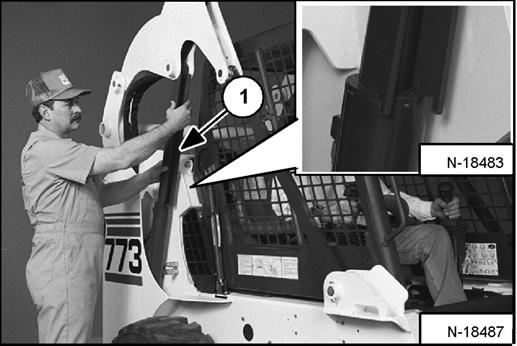
10 minute read
MAINTENANCE SAFETY
Instructions are necessary before operating or servicing machine. Read and understand the Operation & Maintenance Manual, Operator’s Handbook and signs (decals) on machine. Follow warnings and instructions in the manuals when making repairs, adjustments or servicing. Check for correct function after adjustments, repairs or service. Untrained operators and failure to follow instructions can cause injury or death.
W-2003-0903
Safety Alert Symbol: This symbol with a warning statement, means: “Warning, be alert! Your safety is involved!” Carefully read the message that follows.
Correct
Never service the Bobcat SkidSteer Loader without instructions.
WRONG
Use the correct procedure to lift or lower operator cab.
WRONG
Have good ventilation when welding or grinding painted parts.
Wear dust mask when grinding painted parts. Toxic dust and gas can be produced. Avoid exhaust fume leaks which can kill without warning. Exhaust system must be tightly sealed.
WRONG
Stop, cool and clean engine of flammable materials before checking fluids.
Never service or adjust loader with the engine running unless instructed to do so in the manual.
Avoid contact with leaking hydraulic fluid or diesel fuel under pressure. It can penetrate the skin or eyes.
Never fill fuel tank with engine running, while smoking or when near open flame.
Disconnecting or loosening any hydraulic tubeline, hose, fitting, component or a part failure can cause lift arms to drop. Do not go under lift arms when raised unless supported by an approved lift arm support device. Replace it if damaged.
WRONG
Keep body, jewelry and clothing away from moving parts, electrical contact, hot parts and exhaust.
Wear eye protection to guard from battery acid, compressed springs, fluids under pressure and flying debris when engines are running or tools are used. Use eye protection approved for type of welding.
Keep rear door closed except for service. Close and latch door before operating the loader.
WRONG
Never work on loader with lift arms up unless lift arms are held by an approved lift arm support device. Replace if damaged. Never modify equipment or add attachments not approved by Bobcat Company.
WRONG
Lead-acid batteries produce flammable and explosive gases. Keep arcs, sparks, flames and lighted tobacco away from batteries.
Batteries contain acid which burns eyes or skin on contact. Wear protective clothing. If acid contacts body, flush well with water. For eye contact flush well and get immediate medical attention.
Maintenance procedures which are given in the Operation & Maintenance Manual can be performed by the owner/ operator without any specific technical training. Maintenance procedures which are not in the Operation & Maintenance Manual must be performed ONLY BY QUALIFIED BOBCAT SERVICE PERSONNEL. Always use genuine Bobcat replacement parts. The Service Safety Training Course is available from your Bobcat dealer.
Cleaning and maintenance are required daily. MSW07-0805

Service Schedule
Maintenance work must be done at regular intervals. Failure to do so will result in excessive wear and early failures. The service schedule is a guide for correct maintenance of the Bobcat Loader.
Warning
Engine Oil
Engine Air Filter and Air System
Tires
Seat Belt, Seat Bar and Control Interlocks
Instructions are necessary before operating or servicing machine. Read and understand the Operation & Maintenance Manual, Operator’s Handbook and signs (decals) on machine. Follow warnings and instructions in the manuals when making repairs, adjustments or servicing. Check for correct function after adjustments, repairs or service. Untrained operators and failure to follow instructions can cause injury or death.
Service Schedule
Check the oil level and add oil as needed. Do not overfill.
Check display panel. Service only when required. Check for leaks and damaged components.
Engine Cooling System Clean debris from oil cooler, radiator and grill. Check coolant level in recovery tank. Add coolant as needed.
Check for damaged tires and correct air pressure.
Check the condition of seat belt. Check the seat bar and control interlocks. Clean dirt and debris from moving parts.
Safety Signs and Safety TreadCheck for damaged signs (decals) and safety treads. Replace any signs or safety treads that are damaged or worn.
Indicators & Lights (Opt.) Check for correct operation of all indicators & lights.
Operator Cab Check the fastening bolts, washers & nuts. Check the condition of cab.
Lift Arms, Cylinders, Bob-Tach Pivot Pins and Wedges
Fuel Filter
Bobcat Interlock Control System (BICS)
Heater and A/C Filters
Lubricate with multi-purpose lithium based grease.
Remove the trapped water.
Check that four (4) BICS indicator lights and functions are activated. See details in this Operation & Maintenance Manual.
Clean or replace filters as needed during heating/cooling season.
Hydraulic Fluid, Hoses and TubelinesCheck fluid level and add as needed. Check for damage and leaks. Repair or replace as needed.
Final Drive Transmission (Chain case), Foot Pedals or Hand Controls, and Steering Levers
Wheel Nuts
Check oil level. Check for correct operation. Repair or adjust as needed.
Check for loose wheel nuts and tighten to 105-115 ft.-lb. (142-156 N•m) torque.
Parking Brake Check operation.
Spark Arrestor Muffler Clean the spark chamber.
Battery Check cables, connections and electrolyte level. Add distilled water as needed.
Steering Shaft Grease two fittings.
Engine/Hydros. Drive Belt * Check for wear or damage. Adjust as needed.
Fan Drive Gearbox Check gear lube level. Add as needed.
Alternator Belt Check belt tension and adjust as needed.
Engine Oil and Filter
† Replace oil and filter. Use CD or better grade oil and Bobcat filter.
Fuel Filter Replace the filter element.
Bobcat Interlock Control System (BICS) Check the function of the lift arm bypass control.
Hydraulic Reservoir Breather CapReplace the reservoir breather cap.
Hydraulic/Hydrostatic Filter Replace the filter element.
Hydraulic Reservoir Replace the fluid.
Final Drive Trans.(Chaincase)Replace the fluid
Case Drain Filters Replace the filters.
Or every 12 months.
Check wheel nut torque every 8 hours for the first 24 hours.
† First oil and filter change must occur at 50 hours; 250 hours thereafter.
* Inspect the new belt after first 50 hours. Replace filter element after the first 50 hours and when the transmission warning light comes ON.
W-2003-0903
Lift Arm Support Device
Installing Lift Arm Support Device
Warning
Never work on a machine with the lift arms up unless the lift arms are secured by an approved lift arm support device. Failure to use an approved lift arm support device can allow the lift arms or attachment to fall and cause injury or death.
W-2059-0598
Warning
Service lift arm support device if damaged or if parts are missing. Using a damaged lift arm support or with missing parts can cause lift arms to drop causing injury or death.
W-2271-1197
Have a second person install the lift arm support device (Item 1) [Figure PM-2] over the rod of one of the lift cylinders.
The lift arm support device must be tight against the cylinder rod. The tabs of the lift arm support device must be under the cylinder as shown (Inset) [Figure PM-2]
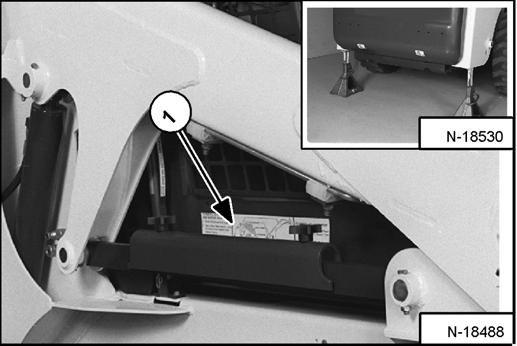
Put jackstands under the rear corners of the loader frame (Inset) [Figure PM-1].
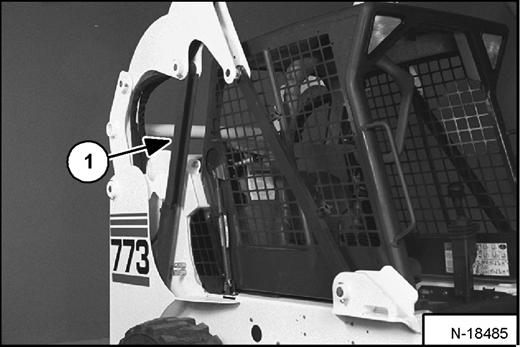
Remove the lift arm support device (Item 1) [Figure PM1] from storage position.
The operator must be in the operator's seat, with the seat belt fastened and seat bar lowered, until the lift arm support device is installed.
Start the engine, and raise the lift arms all the way up.
Lower the lift arms slowly until the lift arm support device (Item 1) [Figure PM-3] is held between the lift arms and lift cylinder.
LIFT ARM SUPPORT DEVICE (CONT’D)
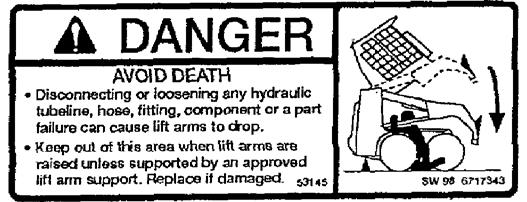
Removing Lift Arm Support Device
The operator must be in the operator's seat, with the seat belt fastened and seat bar lowered, until the lift arm support device is removed and the lift arms are lowered all the way.
Start the engine, raise the lift arms all the way up.
Have a second person remove the lift arm support device.
Lower the lift arms all the way and stop the engine.
Return the lift arm support device to storage position and secure with clamping knobs.
Remove the jackstands.
HEATER AND AIR CONDITIONING Cleaning and Maintenance
The heater and air conditioning system require regular inspection and maintenance. For intervals (See SERVICE SCHEDULE on Page PM-7.)
Figure PM-4
Filters - The Fresh Air Filter is located below the rear window of the cab (Item 1) [Figure PM-4]
Remove the bolts and remove the filter housing. Shake the filter or use low air pressure to remove dirt.
Reinstall the filter and housing.
The Recirculation Filter is located in front of the rear window inside the cab (Item 2) [Figure PM-4]
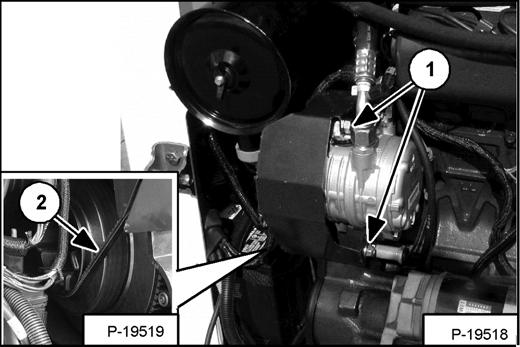
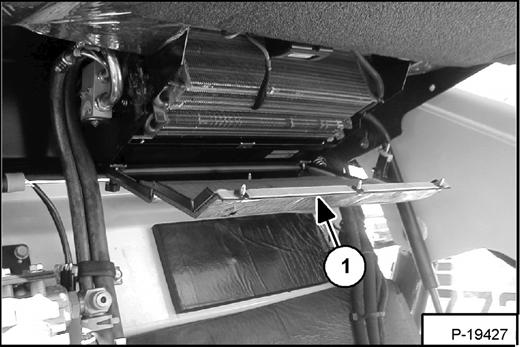
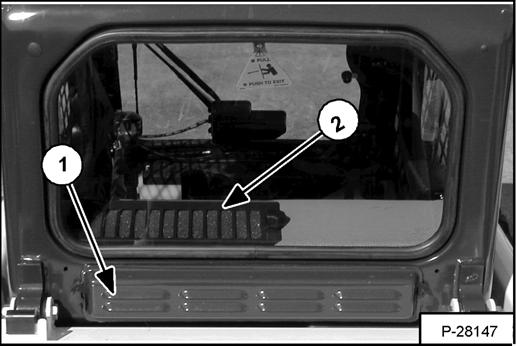
Remove the clamping knobs, grill and filter. Clean the filter with water and mild detergent. Reinstall the filter.
Evaporator
Figure PM-5
Raise the cab and remove the evaporator cover (Item 1) [Figure PM-5]
Use low pressure water or air to remove debris from the evaporator fins.
Install the cover.
Figure PM-6
Air Conditioner Belt Adjustment - Loosen the mounting and adjustment bolts (Item 1) [Figure PM-6]. Move the compressor to tighten the belt (Item 2) [Figure PM-6] Tighten the mounting and adjustment bolts. Check regularly for belt wear.
Air Conditioner Lubrication - Run the air conditioner for about 5 minutes every week to lubricate the internal components.
Troubleshooting - If the fan does not run, or the air conditioning does not turn on, check the fuse. (See ELECTRICAL SYSTEM on Page PM-28.)
If the air conditioning system circulates warm air, the refrigerant may need to be recharged.
Operator Cab
The Bobcat Loader has an operator cab (ROPS and FOPS) as standard equipment to protect the operator from rollover and falling objects. Check with your dealer if the operator cab has been damaged. The seat belt must be worn for roll over protection.
ROPS/FOPS - Roll Over Protective Structure per SAE J1040 and ISO 3471, and Falling Object Protective Structure per SAE J1043 and ISO 3449, Level I. Level II is available.
Level I - Protection from falling bricks, small concrete blocks, and hand tools encountered in operations such as highway maintenance, landscaping, and other construction site services.
Level II - Protection from falling trees, rocks; for machines involved in site clearing, overhead demolition or forestry.
Raising The Operator Cab
Always stop the engine before raising or lowering the cab.
Stop the loader on a level surface. Lower the lift arms. If the lift arms must be up while raising the operator cab, install the lift arm support device. (See LIFT ARM SUPPORT DEVICE on Page PM-8.)
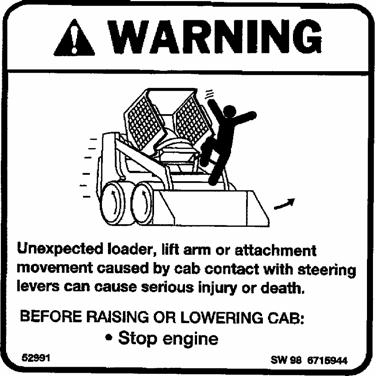
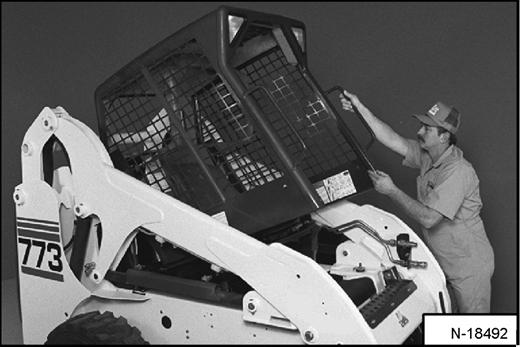
Figure PM-7
Remove the nuts and plates [Figure PM-8] (both sides).
Install jackstands under the rear of the loader frame [Figure PM-7]
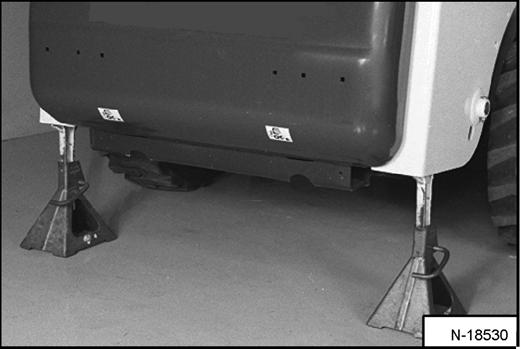
Loosen the nut (both sides) at the front corners of the operator cab [Figure PM-7]
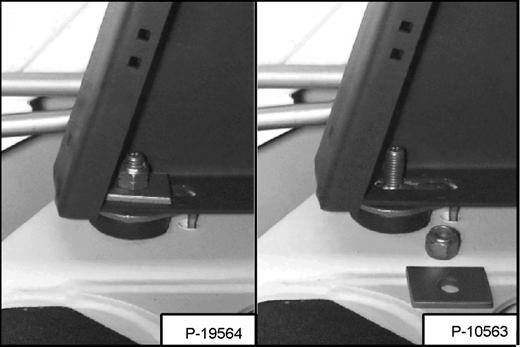
Lift on the grab handle and bottom of the operator cab slowly until the cab is all the way up and the latching mechanism engages [Figure PM-9]
Advanced Hand Controls (AHC) and Advanced Control System (ACS)
OPERATOR CAB (CONT’D)
Lowering The Operator Cab
Always stop the engine before raising or lowering the cab.
NOTE: Always use the grab handles to lower the cab.
Figure PM-10
Warning
Never modify operator cab by welding, grinding, drilling holes or adding attachments unless instructed to do so by Bobcat Company. Changes to the cab can cause loss of operator protection from rollover and falling objects, and result in injury or death.
W-2069-0200
Pull down on the bottom of the operator cab until it stops at the latching mechanism [Figure PM-10]
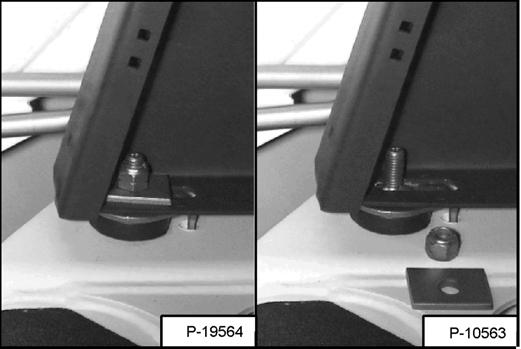
Release the latching mechanism (Inset) [Figure PM-10] and pull the cab all the way down.
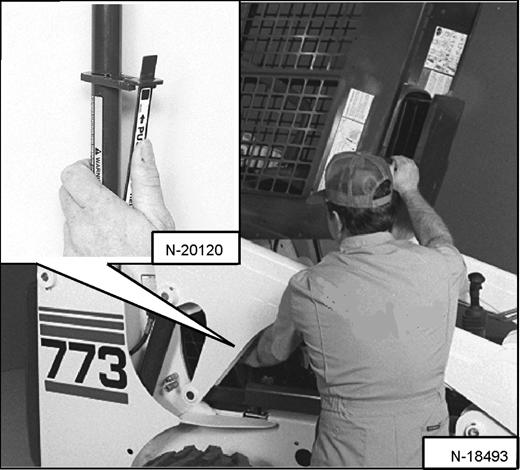
Figure PM-11
Install the plates and nuts [Figure PM-11] (both sides).
Tighten the nuts to 40-50 ft.-lb. (54-68 N•m) torque.
OPERATOR CAB (CONT’D)
Emergency Exit
The front opening on the operator cab and rear window provide exits.
Rear Window (If Equipped)
Figure PM-12
Pull on the tag on the top of the rear window to remove the rubber cord [Figure PM-12].
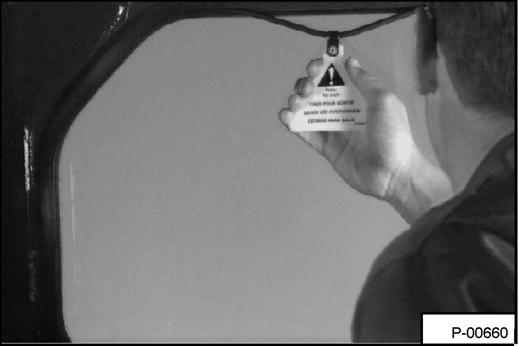
Push the rear window out of the rear of the operator cab.
Front Door (If Equipped)
Figure PM-14
NOTE: When an Operator Cab Enclosure Kit is installed, the window of the front door can be used as an emergency exit. [Figure PM-14]

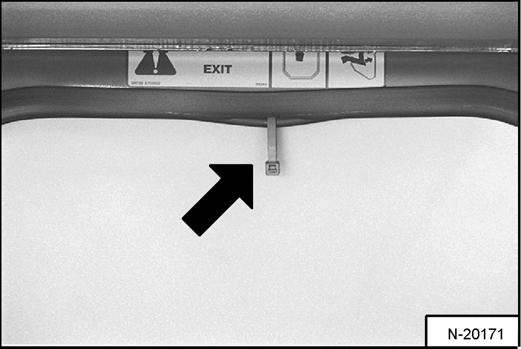
NOTE: If the loader has a Special Application Door Kit installed, the window of the front door is NOT an emergency exit.
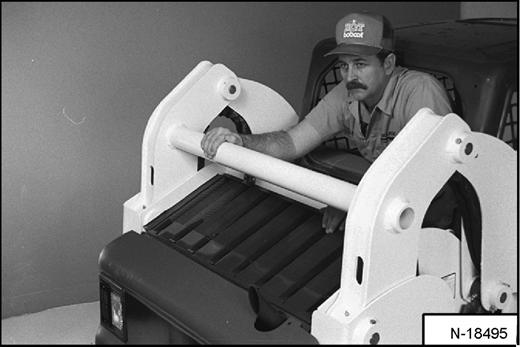
Pull the plastic loop at the top of the window in the front door to remove the rubber cord [Figure PM-14].
Push the window out with your foot [Figure PM-15] at any corner of the window.
Exit through the front door.
SEAT BAR RESTRAINT SYSTEM (FOOT PEDALS)
The seat bar restraint system has a pivoting seat bar with arm rests and hydraulic valve spool interlocks for the lift and tilt functions.
The operator controls the use of the seat bar. The seat bar in the down position helps to keep the operator in the seat.
The spool interlocks require the operator to lower the seat bar in order to operate the foot pedal controls (If equipped).
When the seat bar is down, the PRESS TO OPERATE LOADER Button is activated and the engine is running, the lift, tilt, and traction drive functions can be operated.
When the seat bar is up, the lift and tilt control pedals are locked when returned to the NEUTRAL position.
Inspecting the Seat Bar
Sit in the seat and fasten the seat belt. Engage the parking brake. Pull the seat bar all the way down. Start the engine. Press the PRESS TO OPERATE LOADER Button. Operate each foot pedal to check that both the lift and tilt functions operate correctly. Raise the lift arms until the attachment is about 2 feet (600 mm) off the ground.
Raise the seat bar. Try to move each foot pedal. Pedals must be firmly locked in the NEUTRAL position. There must be no motion of the lift arms or tilt (attachment) when the controls are moved.

Pull the seat bar down, press the PRESS TO OPERATE LOADER Button, lower the lift arms. Operate the lift control. While the lift arms are going up, raise the seat bar. The lift arms must stop.
Lower the seat bar, press the PRESS TO OPERATE LOADER Button, lower the lift arms and put the attachment flat on the ground. Stop the engine. Raise the seat bar and operate the foot pedals to be sure that the pedals are firmly locked in the NEUTRAL position. Unfasten the seat belt.
Maintaining the Seat Bar
See the SERVICE SCHEDULE on the loader, or in this manual for the correct interval. (See SERVICE SCHEDULE on Page PM-7.)
Figure PM-16
Use compressed air to clean any debris or dirt from the pivot points (Item 1) [Figure PM-16]. Do not lubricate. Inspect all mounting hardware. The correct bolt torque is 26 ft.-lb. (35 N•m).
If the seat bar system and hydraulic valve spool interlocks do not function correctly check all electrical wiring and connections. Replace parts that are worn or damaged. Use only genuine Bobcat replacement parts.
Warning
AVOID INJURY OR DEATH
The Seat Bar System must lock the lift and tilt foot pedals or hand controls in neutral when the Seat Bar is up. Service the system if controls do not lock correctly.
W-2263-0597









